
Gujo-Hachiman (郡上八幡) in Gujo, Gifu Prefecture is a very nice, tourist-friendly provincial city with lots to see in a compact area. The city is north of Gifu city, but not as far north as Shirakawa-go. This makes it an easy day trip by bus from Gifu Station or Nagoya. Mid-November for peak autumn colors is a great time to visit.
Central Gujo-Hachiman is scenic with traditional townscapes and photogenic rivers to make walking around town very pleasant. Most major sights are within walking distance from each other. Very unusual that I didn’t see any convenience stores in central Gujo-Hachiman. They are all well outside the tourist sphere. Great for preserving the town’s traditional townscape. If you’re staying overnight or have more time to explore, you can also rent a bicycle to see the sights further away from the center of town.
Gujo-Hachiman used to be a separate town (municipality) called “Hachiman-cho” until it merged with several neighboring towns and villages to form the city of Gujo (pop. 38,000) in 2004.
Here are only a few of Gujo-Hachiman major sights in autumn:
Gujo-Hachiman Castle (郡上八幡城)

Gujo-Hachiman’s main attraction is Gujo-Hachiman Castle on a small mountain named Mt. Hachiman. Takes about 15 minutes to climb up. It’s a fairly easy climb, but people in wheelchairs would require assistance or a car up to the upper parking lot.
The castle buildings are reconstructed, and the main castle tower (tenshukaku) is a 1933 wooden reconstruction. It’s a history museum with a lookout deck on the top floor. Top floor has commanding, panoramic views of the city. Small admission charged.
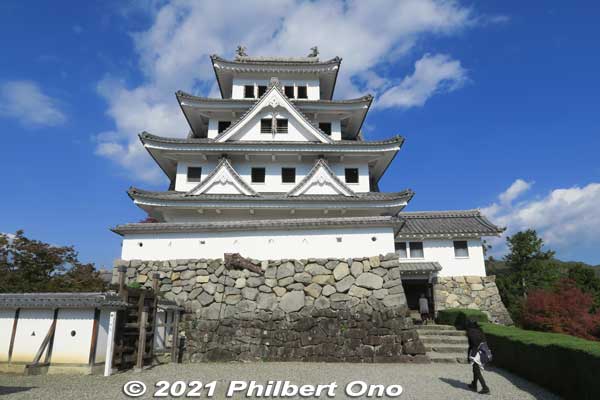
The original castle buildings were dismantled in 1870 when the samurai system was abolished. Only the stone walls and foundations remained. This reconstructed castle tower is unusual because it was built using wood instead of concrete. Japan’s oldest reconstructed main castle tower made of wood.
It’s not an accurate reconstruction of the original castle tower. Apparently, the original floor plan or architectural design did not survive. This reconstruction was modeled after the original main tower of Ogaki Castle in Ogaki, Gifu. Ogaki Castle had been one of the few castle towers preserved after the samurai era ended. It was a National Treasure in Gifu Prefecture until it got destroyed by an air raid in July 1945. Ogaki Castle’s current main tower is a concrete reconstruction.

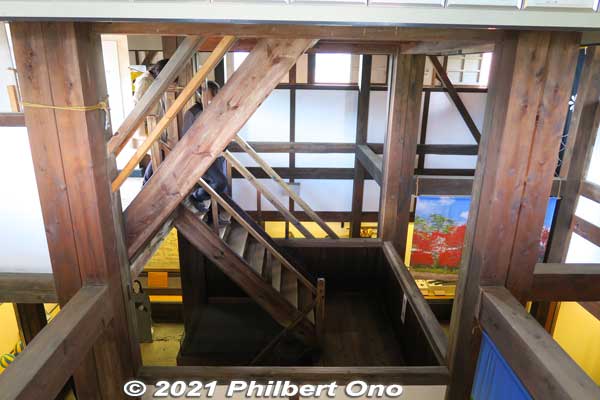
Gujo-Hachiman Castle was first built in 1555 by Lord Endo Morikazu as his base when he was battling another feudal lord, Tono Tsuneyoshi, for the control of the Gujo domain. Morikazu’s son Yoshitaka then unified the Gujo domain and built the castle and castle town.
The succeeding lord, Inaba Sadamichi, built the castle’s main tower. The castle later had other samurai clans as occupants such as the Endo, Inoue, and Kanamori Clans.
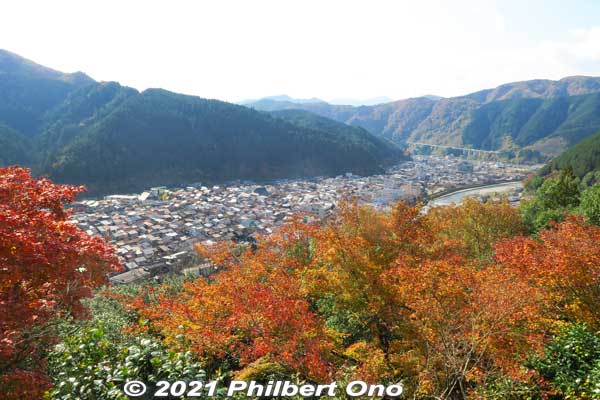


Gujo-Hachiman Castle has numerous red maple leaves and other fall foliage all around. No moats with water, only rivers below.
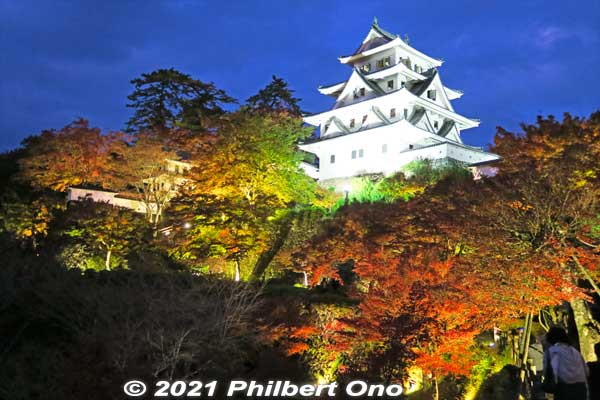
If you have the time, stick around for Gujo-Hachiman Castle and the surrounding foliage to light up at night from 5:00 pm in November. No need to pay admission again to see it at night unless you want to enter the castle tower again. It was kind of tiring to climb up the mountain for the second on the same day to see the evening light-up. But it was worth it.

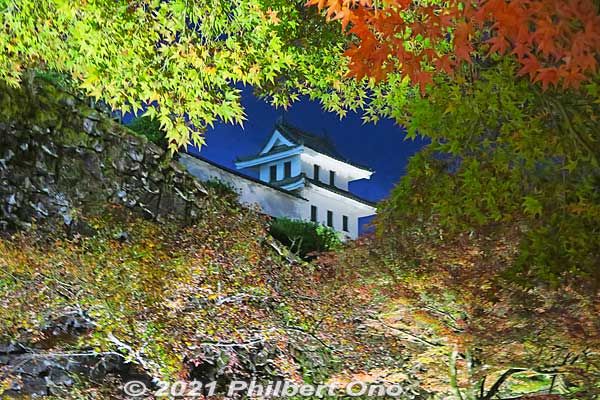
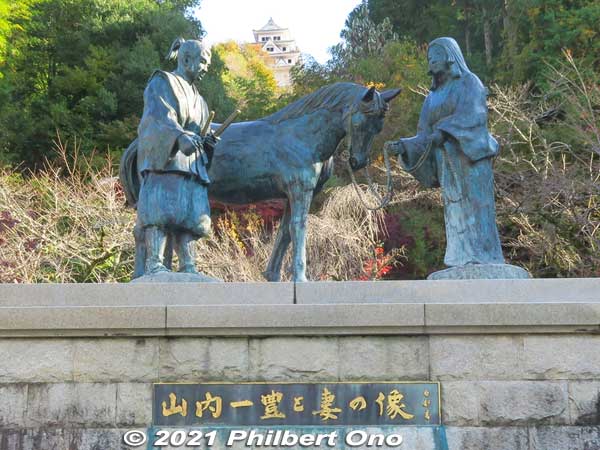
At the foot of the castle mountain, there’s this statue of samurai Yamauchi Kazutoyo and his loyal and loving wife Chiyo and the fine horse she bought for him (in Kinomoto or Azuchi, Shiga Prefecture) with her own money in the 16th century.
Chiyo was supposedly the daughter of the Gujo-Hachiman Castle’s first lord, Endo Morikazu. Husband Kazutoyo became lord of Nagahama Castle in Shiga Prefecture and Kochi Castle in Shikoku. Kazutoyo and Chiyo were made nationally famous by the year-long NHK Taiga Drama series Kōmyō ga Tsuji (功名が辻) in 2006. This statue was erected in 1991 by local donors. (Gujo-Hachiman Castle can be seen in the background.)
More Gujo-Hachiman Castle photos here.
Jion-zenji Temple (慈恩禅寺)
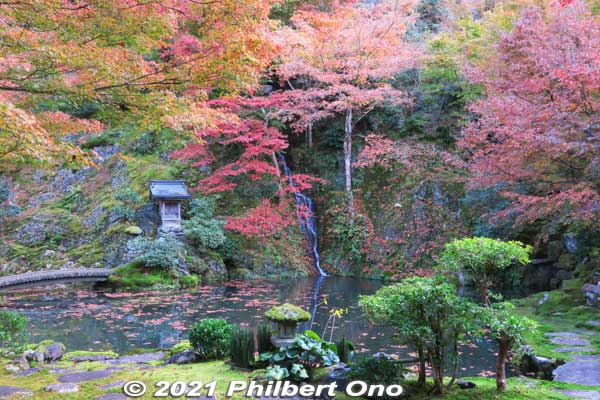
Gujo-Hachiman’s second most famous spot for autumn colors is Tessoen Garden (荎草園) at Jion-zenji Temple (also called Jionji), a Rinzai Zen Buddhist temple (Myoshinji School) on the fringe of central Gujo-Hachiman. It’s a small, picturesque Zen garden with colorful fall foliage. Relaxing, but we cannot walk through the garden. Only view it from a viewing room with an open veranda. The temple’s courtyard and main hall are also impressive see. The temple worships Yakushi, the healing Buddha. Admission is ¥500. In a quiet neighborhood within walking distance from the castle.
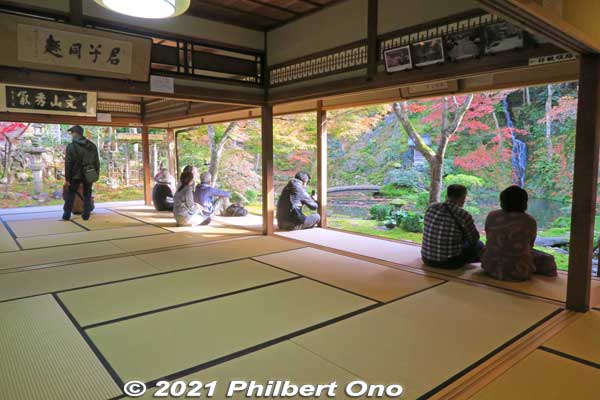
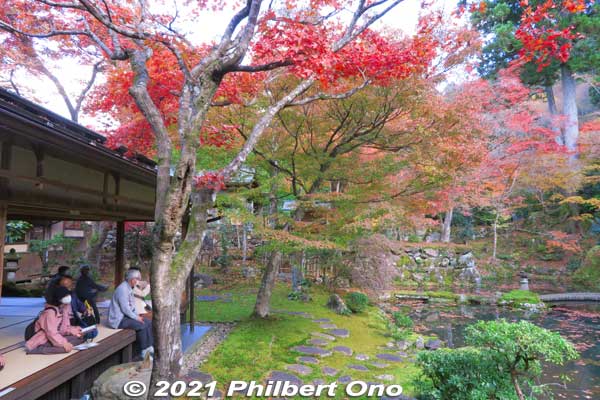
More photos of Jion-zenji Temple here.
Gujo-Hachiman Riverside Walks
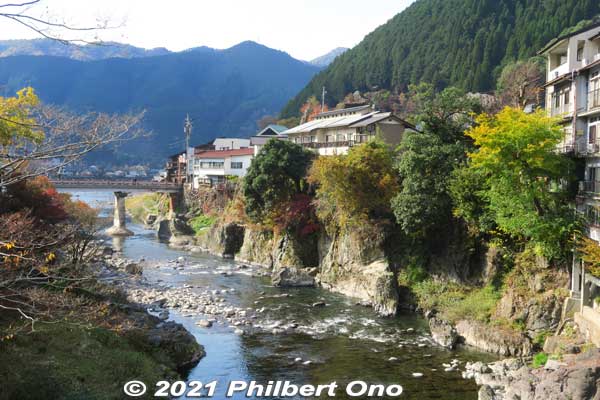
With Yoshida River, Kodara River, and Nagara River converging in Gujo-Hachiman, there’s a lot of picture-perfect river scenes. Riverside walking paths and bridges make it easy to take pictures. The clean river water, ground water, and natural springs make it ideal for many things such as fishing (ayu sweetfish), swimming in summer, soba noodles, and washing (fixing the dye) the giant Koinobori carp streamers in the river in January.
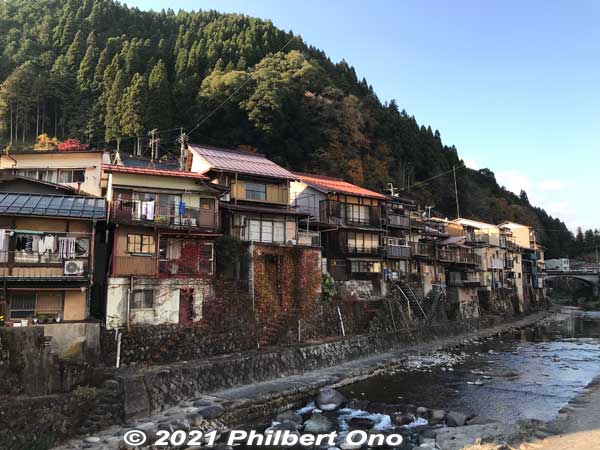
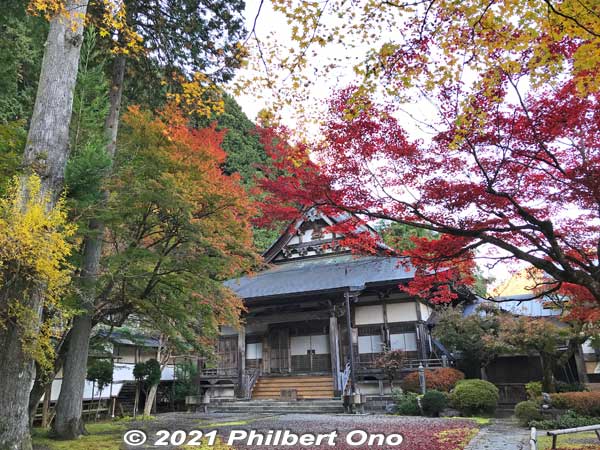

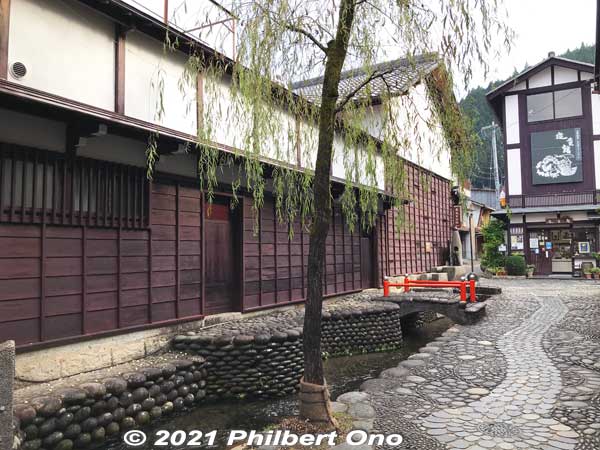
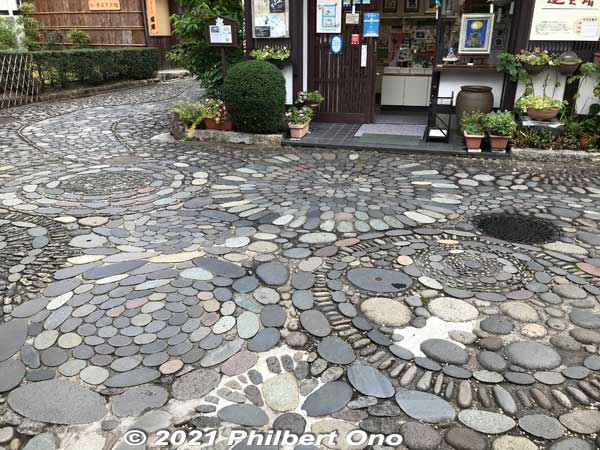
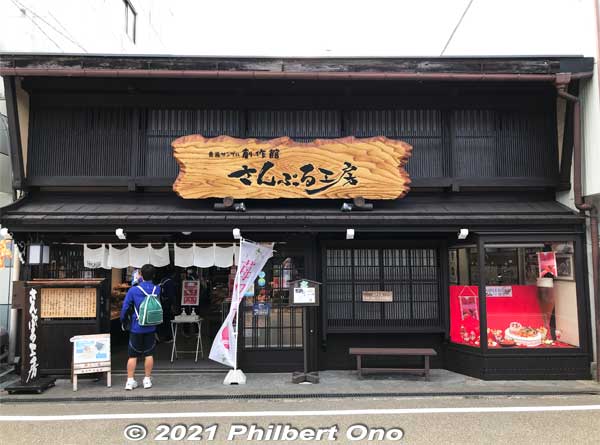

Gujo-Hachiman is also famous for food replicas which were invented by Gujo-Hachiman native Iwasaki Takizo (1895–1965). Iwasaki made his first food replica, an omelette, in 1932. Food replicas were first made with agar and wax. Now they are made with silicone and resin. Food replica companies founded by Iwasaki still make the most food replicas in Japan. Gujo-Hachiman today makes over 50% of Japan’s food replicas.
This prominent shop called Sample Kobo (サンプル工房) near Yoshida River displays a large variety of food replicas and sells food replica souvenirs. They also offer short lessons to make your own food replica. Food replicas in Japan’s restaurants are helpful to foreign tourists who cannot read Japanese menus.
Former Hachiman Town Hall (旧八幡町役場)
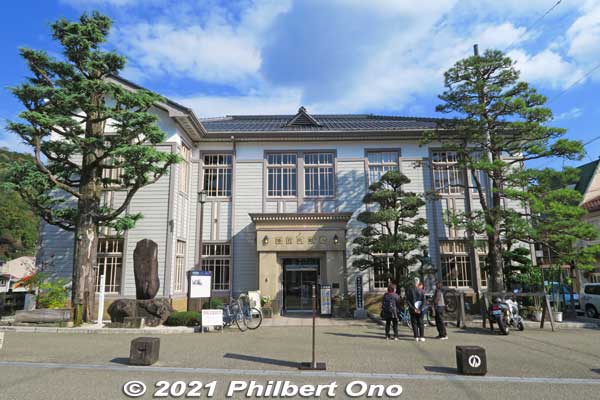
Also near Yoshida River is the former Hachiman Town Hall. Built in 1936, this distinctive building served as the town hall until 1994. It’s now a tourist information center, gift shop, and eatery. Good place to sit down and rest.
In summer, the Gujo Odori dance is held in front of this building as one of the main dance venues.
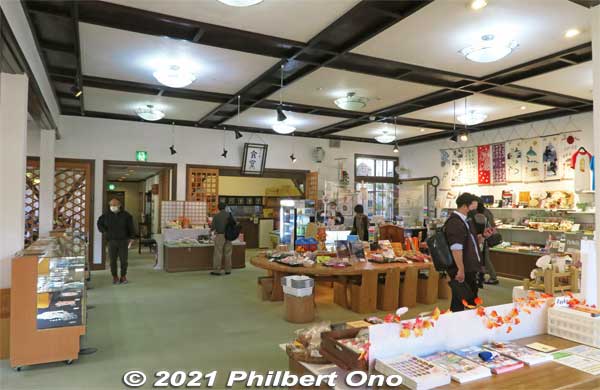
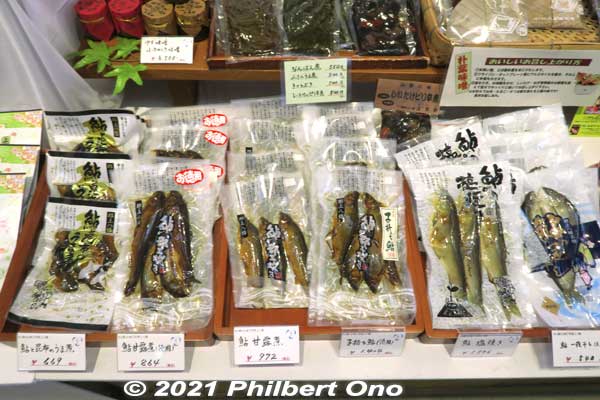
Hakurankan (博覧館)
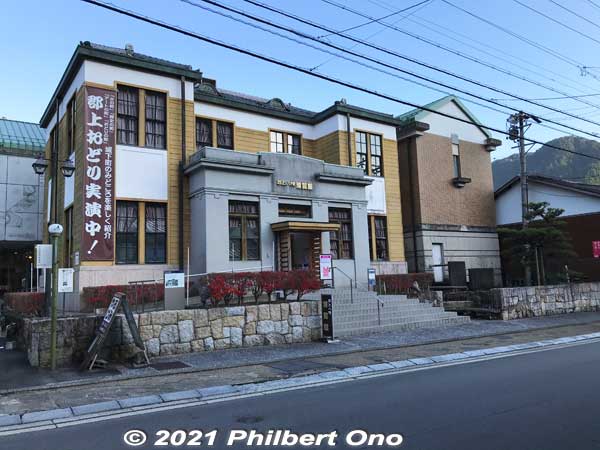
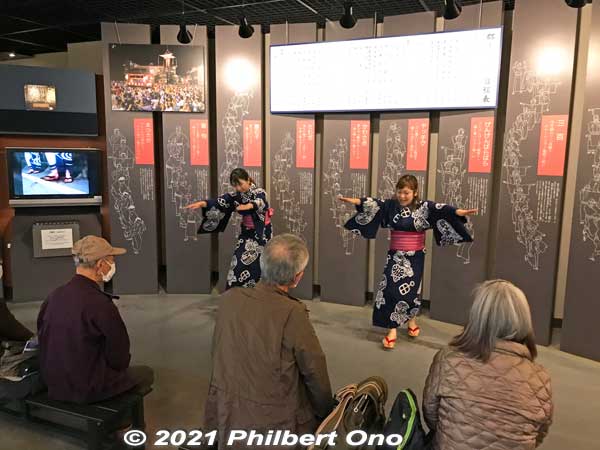
Hakurankan is Gujo-Hachiman’s main museum exhibiting local culture, history, crafts, and ecology. The building was built in 1920 as the tax office. It’s quite extensive.
One museum highlight is the Gujo Odori dance demonstrations held a few times a day at 11 a.m., 12 p.m., 1 p.m., 2 p.m. and 3 p.m. with extra sessions at 10 a.m. and 4 p.m. on Saturdays and Sundays.
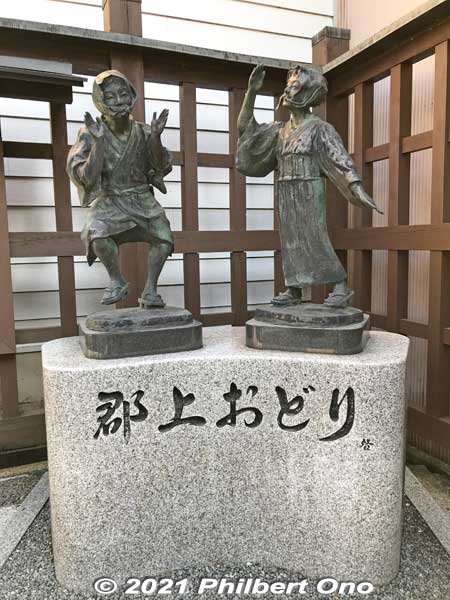
Gujo Odori is what Gujo-Hachiman is most famous for nationally. It’s a Bon dance held every night from mid-July to early September (32 nights). The dance is held in multiple locations in Gujo-Hachiman, but the main dance site is in front of the former Hachiman Town Hall.
During August 13 to 16 (Obon season), they dance all night until 4 am or 5 am, the most crowded period. Sadly, the dance was canceled in 2020 and 2021 due to the pandemic. A Tokyo version of the dance is also held in Aoyama, Tokyo. More info: http://www.gujohachiman.com/kanko/odori_e.html
When I was at the museum, two women dancers (photo) demonstrated all ten Gujo Odori dances with recorded music. They also showed how the wooden geta clogs get worn out. During Gujo Odori, the dances and music go on continuously all night with live music and singers. So when do the musicians take a break?
So happens that there are dance songs with no shamisen or no flutes or no taiko drumming, etc. That’s when those musicians can take a break. Clever. More photos of Hakurankan here.
Museum hours: 9:00 am–5:00 pm, closed Dec 24 to Jan 2. Small admission charged. https://hakurankan.com/group_en/
Getting to Gujo-Hachiman
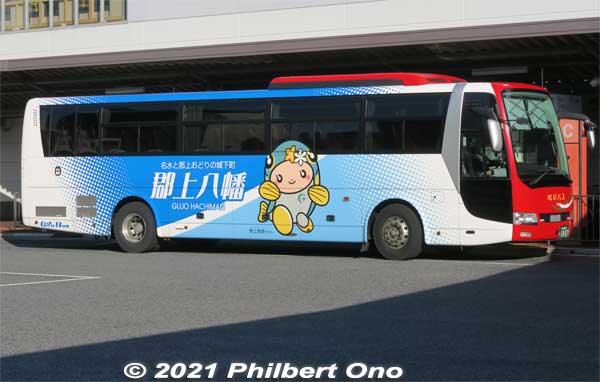
Gujo-Hachiman has a train station (Nagaragawa Railway), but it’s somewhat far from the central part of town. Taking a bus from Gifu or Nagoya Station is more convenient. From JR or Meitetsu Gifu Station, it takes 80 min. on a scenic route through the mountains. Bus fare is only ¥1,550. Buses are well-ventilated with the interior air completely changing every 5 min. to prevent coronavirus infections. Mask wearing is required as of this writing.
Get off the bus at Gujo-Hachiman Jokamachi Plaza which is closest to the castle. This is a gift shop, tourist information desk, and bus stop. Pick up a map or get directions. From here, you can walk to all the sights mentioned above. If you’re visiting on a day trip, check the bus schedule for your return trip. Be aware that buses are infrequent. Only once an hour or less often.

More Gujo-Hachiman photos here.